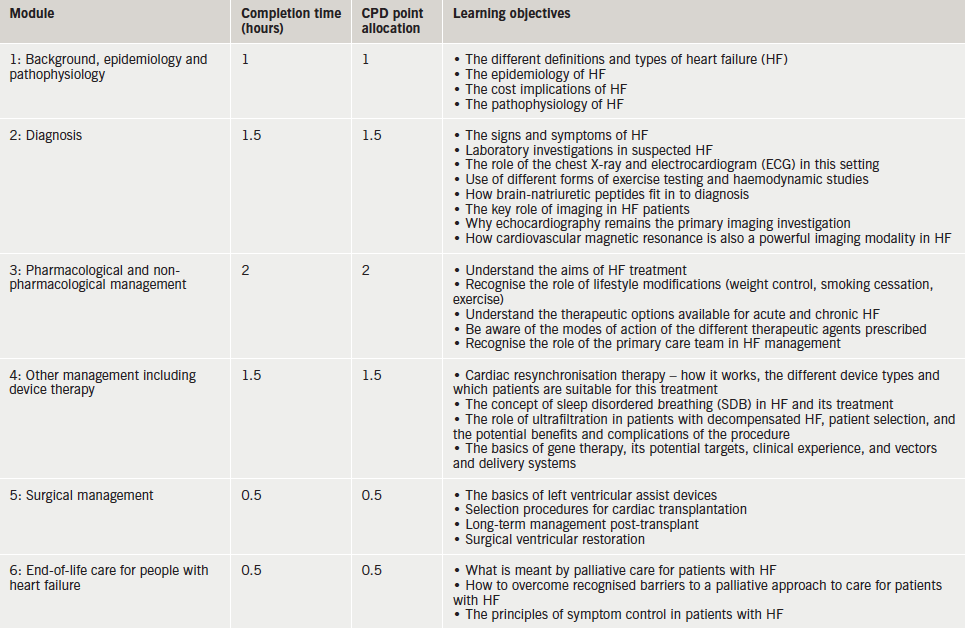BJC Learning: heart failure programme
Publisher: British Journal of Cardiology, 2014
Available from: https://bjcardio.co.uk/learning
In September 2014 the online learning section of the British Journal of Cardiology website released a six-part series of learning modules covering heart failure. As a core medical trainee, I found that theoretical knowledge did not always translate into clinical practice and, prompted by my educational supervisor (the trust heart failure lead), I undertook the online modules to gain further insight when managing complex patients on the wards. The content of each module and continuing professional development (CPD) points allocated is outlined in table 1.
Structure and ease of use
The modules are authored by Professor Andrew Clark, Chair in Cardiology at Hull York Medical School and current Chair of the British Society of Heart Failure, with other senior cardiologists based at trusts across the UK. They take the form of non-interactive text interspersed with graphs, tables and images, with links to videos of relevant clinical signs or investigations. Upon completion there is an end-of-module multiple-choice test requiring a score of 80% for allocation of CPD points and a certificate. Biographies of key contributors, and a video introduction perhaps explaining their motivation for writing the series and placing heart failure in a wider clinical context, would have been welcome.

Simple to navigate, the slides can be enlarged, and supplementary text can be expanded to reveal more in-depth content. References are listed to allow review of the original articles discussed. The modules can be accessed in any order, and the slides clicked through at the users own pace. Allocated completion times are broadly accurate, although I completed each module below the time indicated. Following completion, modules can be repeated to re-enforce learning points, but there is no printable summary sheet; the addition of which would have aided the user taking the key learning points into daily clinical practice.
Learning objectives and assessment
Learning objectives are clearly stated as first page bullet points and each module succeeds in covering its stated objectives, reinforced by the end-of-module tests which I passed first time and noted that many of the questions are tests of memory recall; questions based around a clinical scenario would have been more helpful in assessing the users understanding of the material in practical terms. The tests only give a pass/fail, and not individual scores or corrections of wrong answers, so there remains the potential to introduce a social aspect (comparing scores with other users) and communal learning.
The middle modules, on pharmacological and non-pharmacological management, concentrate primarily on the management of chronic, rather than acute heart failure. Although this is acknowledged as beyond the scope of the series, a section on acute management might be useful for physicians in acute medicine. I would certainly welcome some additional modules outlining the recently published National Institute for Health and Care Excellence (NICE) guidelines on the management of acute heart failure (October 2014).
Educational value in clinical practice
The series provides an excellent overview of heart failure, from pathophysiology and aetiology to diagnosis and chronic management, and includes an introduction to underlying biomedical science and clinical trials that have led to our current understanding of the condition.
For example, the module on management of heart failure starts with a clear overview outlining a management approach from NICE/European Societ of Cardiology (ESC) guidelines. It then discusses each class of drug in more detail, including a summary of the key trials that developed the evidence base for use of the drug. Although supported by an educational grant from Pfizer, the modules are free from bias towards pharmaceutical companies, although the studies discussed are limited to the large trials which showed positive outcomes. As a junior doctor I found the trial summaries sufficient as an introduction, but there is a notable absence of critical appraisal and a primer on understanding of the principals of evidence-based medicine would be useful foreknowledge A brief comment on the relative robustness of the study methodology, as well as reference to alternative studies which did not show a beneficial outcome would further enhance the impact of the modules.
The section on patient education (module 3) lists important topics to discuss with all patients, many of which have significant impact on patients’ quality of life but which are often not considered by general clinicians. This theme is reinforced in the final module on end-of-life care in heart failure that gives practical and specific advice on this topic including, where relevant, appropriate NICE or ESC guidelines. The modules discussing emerging and experimental treatment approaches such as gene therapy are of more academic interest and serve to signpost future therapeutic aspirations.
As a trainee, the key impact here was that the modules provided a solid knowledge of NICE/ESC guidelines for pharmacological and non-pharmacological management of heart failure. I began reading echo reports in more detail, and was confident in suggesting the introduction of new medications or device therapies to my seniors at ward rounds and in clinics. I also started actively screening for common co-morbidities, and began using BNPs routinely when assessing patients with suspected heart failure while on acute medical take.
Who should use this resource?
This series will be of interest to a range of healthcare professionals and most useful for SHO-level doctors, nurse specialists, physician associates and GPs with a special interest in heart failure, as there is no assumption of pre-existing knowledge, but the level of detail covered is more than sufficient to allow informed management of such patients (as well as intelligent discussion with senior cardiologists!). Cardiology registrars at the beginning of their training would also benefit from the modules, as they provide a succinct overview of the key clinical trials on heart failure management.
Conclusions
The six CPD-accredited heart failure modules give a comprehensive overview of our current understanding of heart failure and summarise the key trials that provide the evidence base for current practice, as well as introducing emerging therapies and more holistic concepts. The series represents a well-designed, semi-interactive and clinically relevant educational package, which will benefit a broad range of healthcare professionals.
Dr Andrew Creamer
Core Medical Trainee
Royal Free London NHS Foundation Trust, Pond Street, London NW3 2QG

